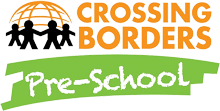At Crossing Borders Preschool, we often use music as a tool to teach children their new language. This is not just because it is fun, though it is! Music and language learning go together like peanut butter and jelly, and when you look at the research, it isn’t hard to understand why. As a language immersion preschool, we make a point to stay ahead of the curve in terms of the best way to learn languages, which is why we always use music in our lesson plans.
MUSIC FOR EDUCATION
Research has shown that music has a powerful ability to help us learn. One Stanford University study found that music increases students’ focus, and another Johns Hopkins study found that putting information to music made it easier to retain and made the experience of learning more fulfilling emotionally and mentally. Generally, it is thought that children acquire language skills, then they learn music. However, there is research to suggest that this is not the case. A recent article published in Frontiers in Psychology argues that an understanding of music is actually essential for learning a new language, and that it in itself is a language that aids us in learning others.
Based on this research, we regularly teach our students songs in their target language, and we have been impressed with the results ourselves. In this blog, we will go over some of the primary benefits we have seen from incorporating music into our language immersion preschool curriculum.
BENEFITS OF MUSIC FOR LANGUAGE LEARNING
Cultural Connection
Music is a universal language. Regardless of the culture, music plays a role. When we teach your child a song in the chosen language, it is connecting them to the millions of people in the culture. They will sing songs that children around the globe have used to learn this language as well. Additionally, we will teach them the meaning and story behind the song, which generally serves as a revealing lesson about the culture in question. Later in life, when your child travels internationally, these songs may even come in handy as they form connections with people from other cultures!
New Vocabulary
Introducing a new song to a student is a great way to introduce new vocabulary. Music provides a unique look into a language because it taps into a specific emotion or tells a story. This presents vocabulary that goes beyond the typical vocabulary list. Music gives the student a fresh perspective on the new language, and the opportunity to learn far more vocabulary words and phrases that are actually used by native speakers of the language.
Take It Home
Music is a great way to practice a language anywhere you go. There are several ways you can incorporate music into your child’s life outside of school in order to reinforce what they are learning at our language immersion preschool. When you are driving your preschooler home from school, sing a song with them in their second language or play a CD of songs in the language. Before bed, you may start adding music into the bedtime routine. Play their favorite song in the second language after you read them a story, or sing it together. You might also find a song in the second language that is about different parts of your day and use it. For example, you could sing a song about breakfast while making it in the morning, or find a song about cleaning that you can sing together during clean up time. There are many ways you can incorporate music into home life to reinforce language learning.
Fun
Simply put, music is fun! This is not an arbitrary factor when it comes to teaching preschoolers (or anyone, for that matter). Our students have a blast learning songs in their new language, and for many of them, it is their favorite part of the day. Music is an important tool because it gets children excited about learning their new language.
At our language immersion preschool, we use music as a tool to immerse your child in a new language. If you are interested in enrolling your child in our language immersion preschool, contact Crossing Borders Preschool today.


